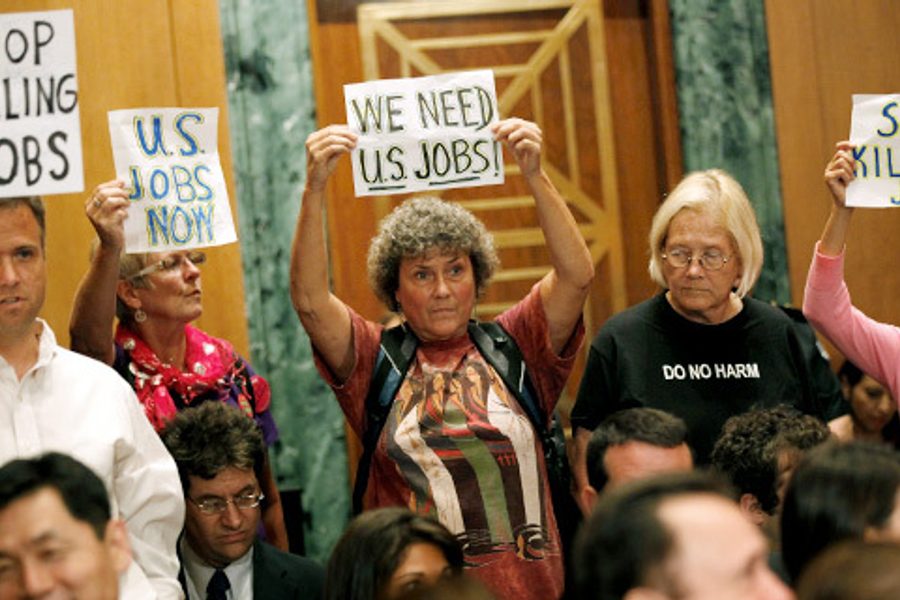
Lately, the usual stream of stories about America’s jobs crisis has been displaced by a story about the shortage of crucial skills among the jobless.
This new narrative — fed by new studies from corporate sources like Deloitte & Touche—has seemingly displaced information about the plight of the unemployed. Suddenly, stories about the unemployed — except for jobless college graduates who are carrying part of the country’s $1 trillion in outstanding student debt—have virtually disappeared from the mainstream media.
What’s happening to the growing numbers of “99-ers,” people whose unemployment benefits have expired? How are families and communities coping with a rising tide of mortgage foreclosures — that, as GOP presidential hopeful Michelle Bachmann of all people reminded us — painfully force families from the security of their “nests”?
Worry not, a new hook for economic coverage has arrived. A major study on the perils posed by the “skill gap” to our economy warns:
American manufacturing companies cannot fill up to 600,000 skilled positions, even as unemployment numbers hover at historic levels, according to a survey released Monday from Deloitte & Touche and The Manufacturing Institute.
…Some companies are not bidding for projects because they lack skilled manpower to do the work, according to Wisconsin Manufacturers & Commerce.
It’s the “jobs paradox,” said WMC President and CEO Kurt Bauer.
“We have high unemployment, yet companies can’t find the skilled help they need,” he said.
Another report from the U.S. Chamber of Commerce National Chamber Foundation and Wisconsin Manufacturers & Commerce received prominent play in the Milwaukee Journal Sentinel, as have a number of other recent stories on the predicted shortage of skilled workers looming soon in Wisconsin’s future:
The report also warns that the state’s workforce is aging, an ominous sign for a labor market that faces an ongoing shortage of skilled workers.
New York Times columnist Thomas Friedman quotes the CEO of Caterpillar about the dangers of inadequate education in what Friedman calls “The Age of Austerity”:
Doug Oberhelman, the C.E.O. of Caterpillar, which is based in Illinois, was quoted in Crain’s Chicago Business on Sept. 13 as saying: “We cannot find qualified hourly production people, and, for that matter, many technical, engineering service technicians, and even welders, and it is hurting our manufacturing base in the United States. The education system in the United States basically has failed them, and we have to retrain every person we hire.”
The highly influential Fareed Zakaria, columnist, TV host and “apostle of globalization…, who has long argued that free trade and globalization are win-win propositions and good for America, now argues that while globalization has been good for American companies, the way it has been operating has not been so good for American workers and job creation,” notes former globalization enthusiast Clyde Prestowitz. Prestowitz goes on to point out:
Astoundingly, Zakaria says this is because the U.S. workforce is not well enough educated. He quotes Pimco bond fund founder Bill Gross as saying that: “Our labor force is too expensive and poorly educated for today’s market place.”
One could easily conclude from these stories and accompanying headlines that a substantial part of America’s unemployment problem is caused by jobless workers’ individual failures to update their skills.
Further, the public schools and the unionized teachers — under attack not just from Republicans like Scott Walker, but also Education Secretary Arne Duncan (see here, and here) and Chicago Mayor Rahm Emanuel (see here and here) — have been failing to properly provide 21st century skills to their students.
Perhaps far too much attention has been devoted to the government role in job creation and retention, when American CEOs need to demand more from their employees and from the U.S. educational system to solve the jobless problem over the long term, this narrative suggests.
But in reality, this whole “Education, Training, and Skills” narrative serves to divert attention from the massive shortage of jobs and Corporate America’s misdeeds to “failing” teachers and supposedly under-educated workers. Corporate America has failed to produce virtually any net gain in U.S. jobs since 1999; the period was the only decade when U.S. employment grew by less than 20 percent.
In short, the Education, Training and Skills “frame” on our economic problems plays several useful functions for the CEOs and the rest of the richest 1 percent. It takes the spotlight off CEOs’ decisions to wipe out decent-paying job opportunities. As Gordon Lafer writes in The Training Charade,
Workers are encouraged not to blame corporate profits, the export of jobs aboard, or eroding wage standards — that is, anything that they can fight — but rather to look inward for the source of their misfortune and the seeds of their resurrection.
It also distracts from a few other things:
THE PROBLEM IS MICROSCOPIC
With 15 million Americans officially unemployed (the number rises to about 25 million when you include the discouraged jobless and those involuntarily working part-time), the relative number of positions going unfilled is infinitesimal in comparison. Just 5 percent of all current manufacturing jobs are unfilled due to a lack of qualified applicants.
Conceivably, a firm commitment by Corporate America and the federal government to maintaining and expanding America’s industrial base, accompanied by an equitable sharing of the massive productivity gains accruing almost solely to corporations, would make work in skilled manufacturing once again attractive. But as illustrated by the direction of leading corporations like General Electric, major firms seem less committed than ever to keeping their manufacturing production in the US. Moreover, leading figures in both political parties resist the notion of an “industrial policy” to foster U.S. manufacturing, as economist Jeff Faux has emphasized.
THE LIMITED VALUE OF TRAINING
When displaced workers successfully complete retraining programs, they are generally unable to find jobs comparable in pay and benefits to the ones they lost. “Out of a hundred laid-off workers,” says New York Times economics writer Louis Uchitelle in his book The Disposable American: Layoffs and Their Consequences, “27 are making their old salary again, or more, and 73 are making less, or not working at all.”
COMPANIES DON’T WANT TO PAY FOR BETTER SCHOOLS
CEOs like Caterpillar’s Oberhelmer feel free to demand that our schools produce well-trained workers. However, corporations like Caterpillar and GE are unwilling to pay the taxes necessary to support quality education for all children. These and other corporations have skillfully avoided paying any federal taxes in some years, and paying minimal taxes in others.
Caterpillar’s Oberhelmer used a frequent corporate ploy in response to tax increases in Illinois. Despite massive increases in profits for the Peoria-based firm, he sent a letter to Illinois Gov. Pat Quinn with a thinly-veiled threat to relocate the corporate headquarters because of a 2 percent tax increase for wealth executives.
Without corporations paying their fair share of taxes, how can they expect a top-notch workforce?
Let us be clear: more education, training, and skills for the unemployed will not produce job opportunities when Corporate America is unwilling to invest in new U.S. jobs, despite the deceptive arguments presented by corporations and allies like Friedman and Zakaria. Nor will public education be able to improve for the children of poor and working-class children when corporations like General Electric and Caterpillar use blackmail threats of relocation to reduce their taxes.
Lafer offers a cold splash of reality on the whole Education, Skills, and Training charade:
Whatever the problem, it seems job training is the answer. The only trouble is, it doesn’t work, and the government knows it… . Indeed, in studying more than 40 years of job training policy, I have not seen one program that, on average, enabled its participants to earn their way out of poverty.

I hope you found this article important. Before you leave, I want to ask you to consider supporting our work with a donation. In These Times needs readers like you to help sustain our mission. We don’t depend on—or want—corporate advertising or deep-pocketed billionaires to fund our journalism. We’re supported by you, the reader, so we can focus on covering the issues that matter most to the progressive movement without fear or compromise.
Our work isn’t hidden behind a paywall because of people like you who support our journalism. We want to keep it that way. If you value the work we do and the movements we cover, please consider donating to In These Times.







